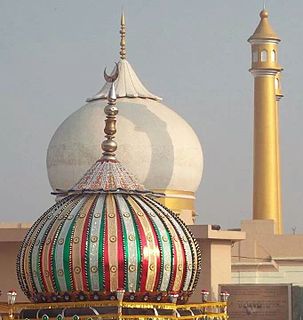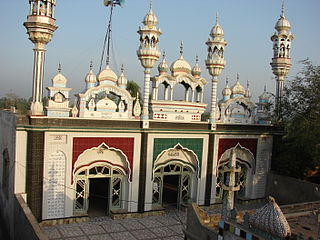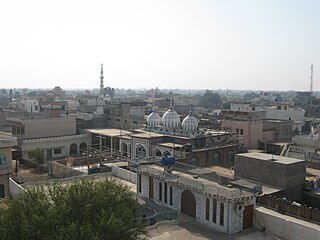
Islam in Mauritius is the nation's third largest religion behind Hinduism and Christianity. Muslims constitute over 17.3 per cent of Mauritius population. Muslims of Mauritius are mostly of Indian descent. Large numbers of Muslims arrived to Mauritius during the British regime starting in 1834 as part of the large scale indentured labor force from India.

Madiga, also known as Maadiga, Maatangi, Makkalu and Mahadiga, are an artisan community. They mainly live in the states of Andhra Pradesh, Telangana and Karnataka, with a small minority in Tamil Nadu.

Bilgram is a town and a nagar palika parishad in Hardoi district in the state of Uttar Pradesh, India. It is located 16 miles (26 km) south of the city of Hardoi, on an elevated bluff that once formed the eastern bank of the Ganges. Important industries in Bilgram include ceramics and embroidery.
Sectarian violence in Pakistan refers to attacks and counter-attacks against people and places in Pakistan motivated by antagonism toward the target's sect, usually a religious extremist group. Targets in Pakistan include the Shia, Barelvis, Sunnis, Sufis, Ahmadis, Hindus and small groups of Deobandis. As many as 4,000 people are estimated to have been killed by Shia-Sunni sectarian attacks in Pakistan between 1987–2007. And since 2008, thousands of Shia have been killed by Sunni extremists according to Human Rights Watch (HRW). One significant aspect of the attacks in Pakistan is that militants often target Sunni and Shia places of worship during prayers in order to maximize fatalities and to "emphasize the religious dimensions of their attack". Human Rights Watch also states that in 2011 and 2012, Pakistan minority groups including Hindus, Ahmadi, and Christians "faced unprecedented insecurity and persecution in the country". Attacks on Sufi shrines by Salafis have also been reported.

The Kilvenmani massacre was an incident in Kizhavenmani village, Nagapattinam district of Tamil Nadu state in India on 25 December 1968 in which a group of around 44 people, the families of striking Dalit village labourers, were murdered by a gang, allegedly led by their landlords. The chief accused was Gopalakrishnan Naidu.

Busal or Bosal is a village in the Mandi Bahauddin District of Punjab, Pakistan.
Hallaur or Hallor village is located in Domariyaganj Tehsil of Siddharthnagar district in Uttar Pradesh, India. Domariyaganj is the nearest town to Hallaur village.
Ubauro is a town in Ghotki District in Northern Sindh province, Pakistan.

Amra Kalan is a village and union council of Gujrat District, in the Punjab province of Pakistan. It is part of Kharian Tehsil and is located at an altitude of 219 metres.

Milkipur is a town and tehsil in Ayodhya district in the Indian state of Uttar Pradesh. Milkipur is 32 km south of district headquarters Ayodhya city. District Ayodhya consists of 11 blocks and Milkipur is a block in Ayodhya, Uttar Pradesh.
Shia Islam was brought to the Indian subcontinent during the final years of the Rashidun Caliphate. The Indian subcontinent also served as a refuge for some Shias escaping persecution from Umayyads, Abbasids, Ayyubis and Ottomans. The immigration continued throughout the second millennium until the formation of modern nation states. Shi'ism also won converts among the local population.
The Halalkhor are a Dalit Muslim community, found in the states of Bihar and Uttar Pradesh in India. The Halalkhor are also known as Shaikhra or Shahani in Bihar and Muslim Bhangi and in Uttar Pradesh.
The Qassab (Urdu: قصاب; from the Arabic word قصاب, are members of a north Indian community or biradari. Occasionally most Quresh caste members are referred to as the Qassab. At present, Qassab who are engaged in meat cutting and selling business are referred to as Qureshi.

Nasirabad is a Nagar panchayat and a Gram Sabha in Chhatoh Block, Rae Bareli district in the state of Uttar Pradesh, India. It was declared a Nagar Panchayat in 2017. Located southeast of Jais on the road to Salon, Nasirabad is an old town partly built on an elevated area that covers the ruins of an ancient fort. It is one of the main Muslim centres in the district. Muslims make up about half the town's population, and the Shia and Sunni communities are both prominent. As of 2011, Nasirabad's population is 13,648, in 2,243 households. It is located 37 km from Raebareli the district headquarters. It is the headquarters of a nyaya panchayat that also includes 6 other villages.
The Pashtuns or Pathans have a large community in the Uttar Pradesh state in India, who form one of the largest Muslim communities in the state. They are also known as khans, which is a commonly used surname amongst them, although not all those who use the surname are Pathans, for example the Khanzada community of eastern Uttar Pradesh, are also commonly known as khan. Indeed, in Awadh, the boundary between the Khanzada and Pathans are blurred. In addition, the phrase Pathan Khanzada is used to describe Muslim Rajput groups, found mainly in Gorakhpur, who have been absorbed into the Pathan community. However, in Rohilkhand, and in parts of the Doab and Awadh, there are communities of partial Pashtuns ethnicities, such as the agricultural farmers community of Rohilla.
Walidpur is a village in Meerut district in the Indian state of Uttar Pradesh.

Anti-Shi'ism is hatred of, prejudice against, discrimination against, persecution of, and violence against Shia Muslims because of their religious beliefs, traditions, and cultural heritage. The term was first used by Shia Rights Watch in 2011, but it has been used in informal research and written in scholarly articles for decades.
The Abaqati family is a sub-branch of the Jarwal-Kintoor branch of Nishapuri Kazmi-Musavi Sayeds who trace their lineage to the Islamic prophet Muhammad through eldest son of great-grandson of Musa al-Kadhim, he was given jagir in Jarwal-Kintoor by Sultan Muhammad Tughluq, other two were given jagir in Budgam, Kashmir and Sylhet, Bengal.
Boniyar(بونیار) is a town and a municipal committee in Boniyar tehsil, Baramulla district in India's northernmost union territory of Jammu and Kashmir. It is located 20 km towards west from district headquarters Baramulla. Boniyar was given tehsil status in 2006. Prominent villages in tehsil Boniyar are Noorkhah, Bagna, Salamabad, Wopal Haq Marg, Athishampora, Bijhama, Trikanjan, Barnate, Uranbuha, Chandanwari, Rampur, Chahla and Nowshera. A major tourist attraction is Lower Jhelum hydropower project at Chalah Boniyar, having a capacity of generating 105 MW. Lachipora wildlife sanctuary has been established for conserving markhoor and other vulnerable animals.
Sahara is a village in Bichpuri Block in Agra District of Uttar Pradesh State, India. It belongs to Agra Division. It is located 13 km towards west from District headquarters Agra. 3 km from Bichpuri. 356 km from State capital Lucknow










